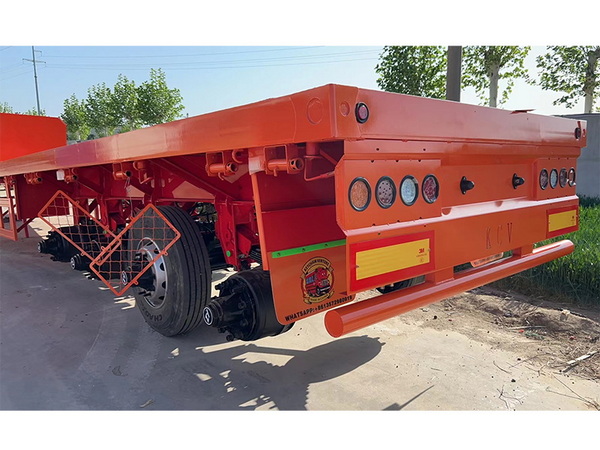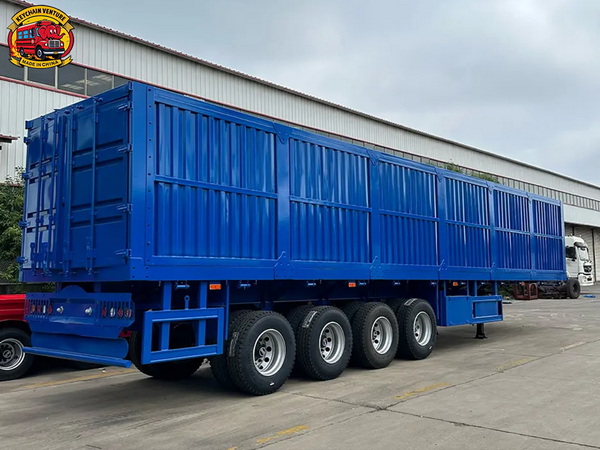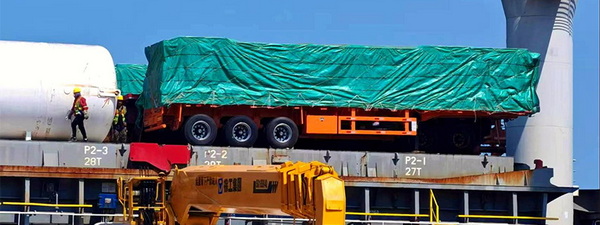Views: 222 Author: Amanda Publish Time: 2025-11-06 Origin: Site








Content Menu
● Axle configurations: common patterns and what they mean
● The roles of axle groups and how they influence operation
● Regulatory considerations and regional variations
● Selecting the right semi trailer configuration for business needs
● Maintenance and safety considerations
● Technological and design trends shaping axle configurations
● Practical guidance for KeyChain Venture Co., Ltd.
● FAQ
>> 1: What is the typical number of axles on a standard semi trailer?
>> 2: How does axle count influence payload capacity and GVW compliance?
>> 3: Are there regions that require higher axle counts for legal weight limits?
>> 4: What maintenance considerations are specific to multi-axle semi trailers?
>> 5: What signs indicate a potential need to adjust axle configuration?
A semi trailer represents a cornerstone of modern freight logistics, delivering flexibility, efficiency, and scale to supply chains across domestic and international markets. For operators, manufacturers, and fleet managers, understanding axle configurations is essential for optimizing payload, meeting regulatory requirements, and ensuring safe, reliable performance on diverse routes. This expanded article delves deeper into the anatomy of semi trailers, explains the roles and interactions of various axle groups, and offers practical guidance for selecting, maintaining, and operating configurations that align with cargo type, route characteristics, and cost considerations. It also explores emerging design trends, maintenance practices, and real-world considerations that influence total cost of ownership for commercial vehicle fleets.

A semi trailer is a specialized trailer designed to be coupled to a tractor unit via a semi-trailer hitch, also known as a kingpin connection. The trailer relies on the towing vehicle to bear a portion of the weight and to provide steering and braking control, with the load distributed between the tractor and trailer. Semi trailers cover a broad spectrum of configurations to accommodate different cargo types, weights, and operational requirements, from lightweight goods to heavy, dense freight, to containers and modular loads. The designation “Semi Trailer” is a standard term in logistics and construction sectors worldwide, reflecting a versatile platform that is central to efficient distribution networks.
- Standard five-axle configuration: In many markets, the most common setup comprises two front steering axles on the tractor, two drive axles at the tractor's rear, and one axle on the trailer. This arrangement balances steering control, drivetrain traction, and cargo support, delivering robust performance for a wide range of long-haul and regional freight tasks.
- Multi-axle trailer variants: For heavier shipments or challenging routes, some semi trailers adopt three or more axles on the trailer side (or a combination of three trailer axles with tractor axles). Increased trailer axles expand potential payload and improve load distribution, but demand careful alignment with per-axle weight limits, maneuverability considerations, and regulatory compliance.
- Lightweight or urban configurations: In markets prioritizing maneuverability and reduced tare weight, certain applications may employ fewer than five axles. These configurations emphasize turning radius and fuel efficiency, often for shorter-distance or high-traffic urban deliveries, while potentially limiting maximum payload.
- Special-purpose arrangements: In niche operations such as heavy-haul, container transport, or specialized modular cargo, distinctive axle patterns like tandem-drive axles with lift or inter-axle steering capabilities may be used to tailor performance to specific loads and road conditions. These setups require careful planning, licensing, and route-specific permits.
- Tractor front steering axles: These axles enable precise steering and contribute to overall maneuverability, especially during changes in direction or when navigating tight road segments. Their load-bearing role is integral to vehicle control at all speeds.
- Tractor rear drive axles: Drive axles deliver propulsion and traction. More drive axles generally improve acceleration, hill-climbing ability, and stability on slippery or uneven surfaces. They also influence drivetrain wear and fuel economy, depending on load and terrain.
- Trailer axles: The trailer's axles bear the bulk of the cargo weight and play a critical role in weight distribution, braking performance, and ride quality. The number and spacing of trailer axles affect stability, braking balance, and the permitted gross vehicle weight (GVW) in a given jurisdiction.
- Weight limits by region: Different jurisdictions regulate how weight is distributed across axles and overall GVW. Some places permit higher GVW with additional axles, while others impose per-axle weight ceilings or require special permits for heavier configurations.
- Permits and route planning: When axle counts or overall weights exceed standard limits, operators may need route-specific permits and coordinated logistics planning to avoid penalties and ensure safe transit.
- Road infrastructure and safety objectives: Axle configurations are influenced by road bed strength, bridge clearances, and traffic safety considerations. Operators must stay informed about evolving rules and best practices in the markets they serve.
- Cargo characteristics: Heavier and denser freight often benefits from extra axles to distribute weight and maintain adequate braking efficiency, while lighter loads may tolerate simpler configurations with lower upfront cost.
- Route profiles and climate: Mountainous, high-altitude, or variable-weather routes may require axle setups that optimize traction and braking on slopes and wet or icy surfaces.
- Maintenance, reliability, and lifecycle costs: More axles can increase initial purchase price and maintenance demands, but may reduce per-axle wear and support safer operation under heavy loads. A holistic view of total cost of ownership informs the best choice.
- Containerization and modular loads: For cargo that relies on standardized containers or modular units, axle configurations should align with container handling equipment, chassis compatibility, and yard operations to maximize efficiency.
- Inspection routines: Regular checks of tires, brakes, suspensions, and axle assemblies are essential for identifying wear patterns, misalignment, and potential safety issues.
- Alignment and wheel wear: Proper alignment across all axles minimizes uneven tire wear, improves fuel efficiency, and ensures predictable handling.
- Braking performance: Multi-axle braking systems require coordinated maintenance to ensure balanced braking force and consistent stopping distances across all axles.
- Suspension systems: Axle-mounted suspensions influence ride quality and cargo protection. Routine inspection helps prevent cascading failures and preserves cargo integrity.

- Weight distribution planning: Plan loading to achieve balanced weight across axles, using scales or load distribution tools to verify compliance before departure.
- Load securement and restraint: Secure cargo with appropriate tie-downs, dunnage, and containment to prevent shifting that can alter axle loading during transit.
- Route and regulatory compliance: Verify that the chosen configuration complies with local and national rules for GVW, per-axle limits, and permit requirements, adjusting routes as needed.
- Driving technique and safety: Operators should modify driving behavior to reflect the chosen axle configuration, including speed management, braking strategies, and cornering awareness.
- Lightweight materials and robust design: Advances in materials science and engineering reduce tare weight while preserving strength, enabling greater payload capacity without exceeding GVW limits.
- Advanced braking and stability systems: Modern semi trailers incorporate enhanced braking control, anti-lock braking, and stability aids to improve safety across a variety of axle layouts.
- Telematics and real-time monitoring: The integration of sensors and fleet management software enables proactive maintenance, weight monitoring, and route optimization, improving reliability and cost efficiency.
- Client-first approach: Assess typical cargo types, route networks, and regulatory environments when recommending axle configurations, prioritizing safety, efficiency, and total cost of ownership.
- Domestic and export considerations: Align semi trailer designs with national standards and container handling practices to maximize versatility and global reach, supporting both domestic Chinese markets and international shipments.
- Content strategy: Use visual aids and videos that illustrate weight distribution, loading practices, and axle dynamics to educate readers and customers, while ensuring all media remains relevant and up-to-date with industry standards.
Axle configuration remains a central design choice in semi trailer engineering, balancing payload capacity, safety, maneuverability, and cost. The five-axle standard—two steering axles on the tractor, two drive axles on the tractor, and one trailer axle—continues to be a versatile baseline for many applications, delivering reliable performance across diverse cargo profiles. Nevertheless, specialized operations may justify alternative configurations, provided compliance with weight limits, licensing, and safety protocols is maintained. For KeyChain Venture Co., Ltd., delivering high-performance Semi Trailer solutions requires a holistic approach: matching cargo characteristics to route demands, leveraging advances in materials and braking technology, and embracing data-driven maintenance and route optimization to achieve greater reliability and lower total cost of ownership.

A1: A standard setup often uses five axles total—two on the tractor front, two on the tractor rear, and one on the trailer, with regional variations possible.[11][12]
A2: More axles distribute weight more evenly, enabling higher gross vehicle weight within per-axle limits and improving braking efficiency and stability.[1][11]
A3: Yes, regulatory frameworks vary; some jurisdictions permit higher GVW with additional axles, while others impose strict per-axle and per-vehicle limits.[2][5]
A4: Regular inspection of tires, brakes, suspensions, alignment, and axle components across all axles is essential to safety and performance.[4][1]
A5: Uneven tire wear, pulling, vibrations, and degraded braking performance can signal load imbalance or suspension wear requiring assessment.[10][1]
[1](https://haletrailer.com/blog/types-of-semi-trailer-axles/)
[2](https://www.sunhunk.com/about/groupnews-detail-226.htm)
[3](https://www.linkedin.com/pulse/understanding-semi-truck-axle-configurations-s4e3f)
[4](https://www.tecequipment.com/blog/a-comprehensive-guide-to-semi-trailers/)
[5](https://www.volvotrucks.com/en-en/news-stories/insights/articles/2019/nov/how-to-determine-the-right-axle-configuration-for-your-truck.html)
[6](https://www.youtube.com/watch?v=BjHXyLHiEoo)
[7](https://www.lawtrucks.com/latest-news/different-types-of-truck-axles)
[8](https://www.basworld.com/content/how-axle-configurations-work)
[9](https://www.paigelogistics.com/resources/truckload-trailer-types/)
[10](https://www.lasvegasmobilesemirepair.com/how-many-axles-in-semi-truck/)
[11](https://en.wikipedia.org/wiki/Semi-trailer_truck)
[12](https://wewin.com/understanding-big-rigs-exactly-how-many-axles-does-an-18-wheeler-have/)